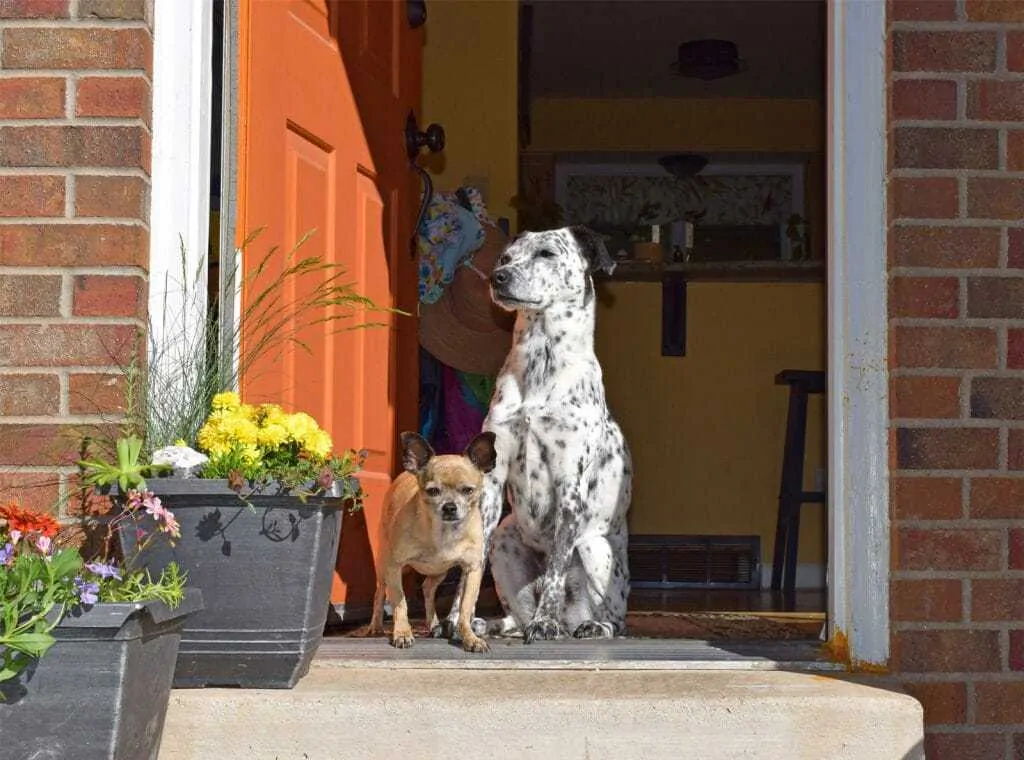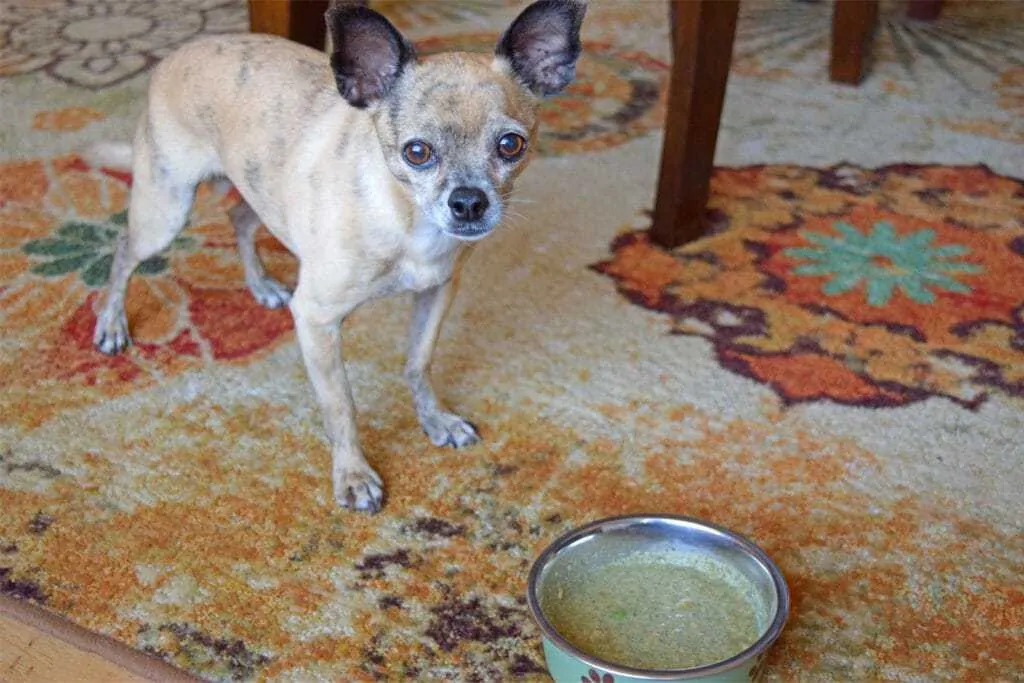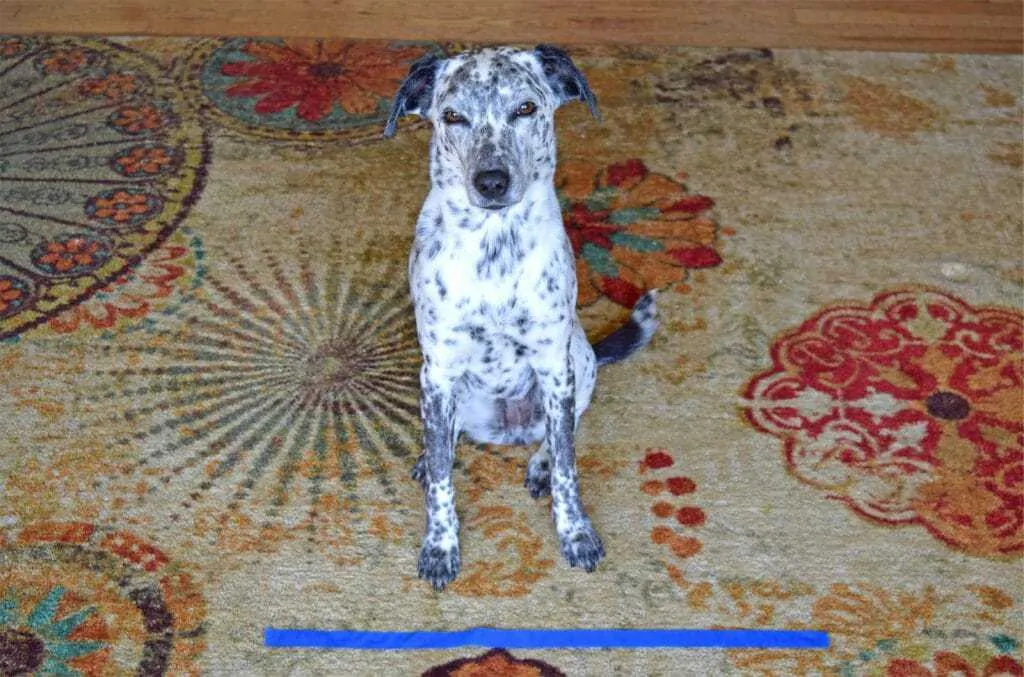I still remember teaching my chocolate labrador the stay command for the first time back in 4-H as a kid. It was an important concept for her to master. In the show ring, she would be expected to sit for a full minute without getting up or lying down. And then there was the dreaded down stay. Five whole minutes where she was expected to stay almost as still as a statue.
There was no better feeling than a successful down stay in the ring.
But for the average companion dog, the stay command is far less useful. How often do you really need your dog to stay in the same position for an extended period? Yet, it’s still one of the first commands they teach in puppy class.
The wait command is useful in many areas, but using it to keep your dog safely inside an open door is one of the most important times to utilize this command.
Stay still has its place in the domestic dog’s life, but there is another command that can be far more useful for the average owner. And teaching it in combination with stay will help both you and your dog find some clarity and understanding.
Let’s dive into the true meaning of the stay command, how we constantly undue our hard work by using it incorrectly, and how the introduction of the wait command is a lifesaver for most owners.
Contents
The Traditional Stay Command
The stay command has a very specific meaning. When told the “S” word, your dog is meant to stay put. They should not move forward, backward, or even change positions.
It’s a very specific command that’s useful in very specific situations.
While I personally feel the wait command is much more important for a dog to learn, there are some key instances where having your dog stay frozen in place is important.
The stay command is important for situations when you need tight control over your dog like while out in public or when playing hide the treat games in your yard.
For dogs that compete in any type of competition or sport, stay is paramount. A retriever wouldn’t be very useful or very safe if they leaped into action before the gun was fired. An overzealous border collie could easily blow a competition if they took off too soon, whether they’re herding sheep or fly balls.
>>>If your dog is still early in their training, there are a lot of great books out there that can help you get started on the right foot.
Even in the home, the stay command has its place. Asking your dog to sit and stay before mealtimes is just plain good manners. Being able to ask them to stay down on their bed while you escort an elderly relative through the door is an important trick to keep in the arsenal.
But more often than not, when we tell our dog to “stay” what we’re really asking them to do is to “wait.”
How the “Wait” Command is Different
While stay and wait seem similar in terms of their English meaning, when you’re speaking dog, they mean two very specific things.
Stay means to freeze in the exact position you were left. While wait, on the other hand, simply means do not move forward into this space.
Before you write this trick off as a silly party gag (Look! My dog won’t step over that crack in the floor!), consider the many uses.
Does your dog dart through the front door whenever you try to enter or exit? The wait command will solve that. Does your pooch often get tangled in your feet while you’re carrying laundry up the stairs? Wait is the perfect solution! Do you wish your dog would stay out of the kitchen while you’re cooking? Wait strikes again!
Practicing wait at feeding time will help strengthen the behavior by adding the powerful reward of a full bowl of food.
There are unlimited uses for this versatile command. I want my dog to stay out of the mudroom while I’m preparing his dinner, but I don’t care if he stays in a sit while I do it. He can stand, lay down, or walk away. It’s all the same to me as long as he’s not under my feet!
And that is the main difference between situations that call for stay and those that are better suited for wait.
>>>Another behavior all dogs should know is how to walk politely on a loose leash.
Why It’s Important to Teach Wait if You Teach Stay
If you’ve ever tried to change your dog’s behavior (like teaching them not to jump up or beg), you know that consistency is key. But the need for consistency applies to command training as well. If you teach your dog to sit but then only enforce the sit half the time that you ask for it, your dog will never sit on command reliably.
It’s the same with stay. If your dog gets up before being released from a stay, and nothing happens (meaning you don’t correct them by putting them back into the stay), then your dog will never stay reliably.
A stay command that hasn’t been consistently enforced is likely to lead to disaster when you try to use the command in a real-life situation. By only asking for a stay when you will be around to release them, you’ll keep the command reliable and avoid losing control of your dog in future situations.
You may not really care if your dog remains in a perfect sit stay while you bring the groceries through the door, but you will care when you’re trying to take their picture for your Christmas card.
This is where the addition of the wait command can make your life a thousand times easier.
When you ask your dog to stay, they should remain there until released. If you tell your dog to stay so they don’t bolt out the door when you leave for work, theoretically, they should still be standing by the door when you return. If they’re not, then you can bet your stay command just got a little weaker.
>>>Want to make training more enjoyable for you and your dog? Make sure you have the right training equipment to be successful.
But, if you ask your dog to wait as you leave for work, the closed door prevents them from not following your command. And they are free to wander the house in your absence. The behavior stays reliable because your dog can’t not comply. And your stay command becomes more reliable because you will only need to use it during times when you truly want your pup to stay still and will reinforce that exact behavior.
How to Teach Your Dog Wait Using the Traditional Method
Ready to add the wait command to your dog’s vocab? Grab some extra tasty treats, your treat pouch, and let’s get started!
When teaching wait with the traditional method, using a threshold or a line on the floor will help you stay consistent about correcting your dog when they move forward by giving you a visual marker.
Step 1: Get set up
The first thing you need to do is to find the right spot in the house to teach this behavior. You will need either a threshold, like an open doorway or a transition between carpet to tile. You can even put a short strip of painter’s tape on the floor. The visual aid of a threshold or line will help you to be honest and consistent in correcting your dog if they move forward.
If your dog is clicker trained, you can use your clicker in conjunction with praise and treats during these steps.
Step 2: Add distance
Begin with your dog in front of you and the line or threshold between you. They can be standing, sitting, or lying down but don’t ask them to do anything in particular. Now, tell your dog to “wait” and hold out either one finger or a closed fist (or any unique hand signal that does not resemble your stay signal).
While still facing them, take one small step backward. Wait for only a second or two, and then step back to them. Praise them, treat them, and release them with your release word (“free” or “all done” are good choices).
TIP: If your dog does step over the line, simply correct them with an “eh eh” or “nope” and get them back into position, and step back again. Try for less distance the next round and work in smaller intervals. Remember, it’s ok if your dog changes positions or turns and walks in circles, so long as they don’t cross the line.
>>>Wondering why we recommend a correction “marker” rather than more traditional correction methods? Read about why punishment should be avoided during training.
With each successive repetition, increase your distance but still only wait about a second or two before returning to your dog. Praise, treat and release each time. Keep working until you can easily walk backward away from your dog about ten steps and have them successfully wait.
As you can see in this clip, Pyro the chihuahua offers both sits and downs when asked to wait. So long as he doesn’t move forward over the line he is free to take any position he wants and even move between them.
Now, return to the starting position. Ask your dog to “wait” and take one step away, but this time do it with your back turned. If your dog waits, turn back around and treat and release. Continue building your distance again with your back turned toward your dog as you move away. If your dog steps over the line, correct them as you did before.
TIP: If your dog frequently struggles to understand you during training, check out our article on common training mistakes to see if there might be a solution to your communication problems.
Step 4: Add time to distance
Once your pup has mastered distance, you’ll start adding more wait time to each repetition.
Start as you did before. Ask for a “wait” and take one step back while facing your dog. Wait three to five seconds before returning to your dog and treating and releasing. The next time, take two steps back and wait three to five seconds. Repeat, adding a foot or two each time, until you can successfully move about ten steps away and wait five seconds before releasing.
Step 5: Vary time and distance
At first, don’t wait more than five seconds before releasing your dog. Once your dog is confident with a little time on top of a lot of distance then you can add additional time.
Instead of working in increasing intervals as we were before, vary your distance and your time for each repetition. For the first rep, take only a couple steps back and wait about five seconds. Then take ten steps back and wait ten seconds. Then take five steps back and wait ten seconds. Then take two steps with your back turned and wait five seconds. Keep varying your time and distance with each rep, but work toward an overall goal of longer distances and times.
By varying time and distance you keep your dog guessing. And that uncertainty about when the next treat is coming will actually keep them performing better than if time and distance were being consistently increased.
Once you can confidently take ten steps with your back to your dog and wait 30 to 60 seconds, you are ready to practice this behavior in a new environment. Make sure to return to step 2 and work on distance only before adding the time variable, each time you move to a new environment.
TIP: Keep in mind, this may take multiple training sessions to accomplish. Work at your dog’s pace and only so long as they are enjoying the challenge and making some progress.
How to Teach Your Dog “Wait” Using a Door
By far, the most common and useful place for the versatile wait command is at the front door. If you plan to use this command in this situation the most, you can train your dog using this method instead. If you plan to use wait in multiple situations including at the door, you should teach your dog using both methods.
>>>Looking for another useful behavior to teach your dog? Target training is fun and can be shaped into many helpful behaviors.
Step 1: Get set up
This method works best if you train on a door your dog likes to bolt through (or at least the one you will be using the wait command with the most). Put a leash on your dog and loop it around your wrist as a safety line to prevent them from running out the door.
In this method, you will use the reward of getting to walk through the door, so treats are not needed. However, if your dog is not especially motivated about going outside, you may need to throw some treats out the door to give them something on the other side to be excited about.
Consistently using the wait command when you go through the door will also help your dog learn not to bolt through open doors, a behavior that can be incredibly dangerous.
Step 2: Use the door opening as a reward
Start with the door closed and your dog on the side of you closest to where the door will open. Ask your dog to “wait” and give them the hand signal. Then, slowly open the door. The moment your dog attempts to move through the door, close it. If your dog manages to to get their snout in the door before you can close it, use your correction marker and move them back into position. They will learn much faster if you can get the door closed before they slip between it and the doorframe.
Do not repeat the command or hand signal once you have closed the door. Simply start opening it again after they have moved back into position. Each time they move toward the door, shut it.
Repeat this process until you can successfully open the door all the way without your dog moving forward. Once the door is fully open, release them and walk through the door. Give them plenty of praise and love on the other side. Continue to work through these steps until you can easily open the door, wait a couple of seconds, and then release your dog through.
TIP: If at any point your dog “loses the plot” or is really struggling to understand what you want them to do, simply walk them away from the door, get them refocused, and then give the command again.
When using the door method to teach your dog wait, remember that the leash is just a safety line. Use the door to keep them from running out before they are released instead of tugging on the leash.
Step 3: Add stepping through the door
The wait command works great as a way to get your dog to politely let you walk through the door first when you’re taking them on a walk. But, odds are, you’re going to be utilizing this command more for when you are leaving the house and they are staying behind. This next step will help with that particular situation.
Set your dog up as you did before. Make sure they are still leashed. Give them the “wait” command, open the door, and then take one step through. If your dog follows, use your correction marker, back them up into position and close the door. Without giving the command again, open the door and try to step through again.
Once you can successfully step through without your dog moving forward, release them to move through after you and shower them with praise.
Repeat this until your dog can easily wait for you to step through the door and then wait an additional few seconds for the release.
TIP: When you use this in real life, like when leaving for work, there will be no reward or release. In order to keep the behavior reliable and reinforced, use your wait command when going on walks and in other situations that will allow you to reward your dog by letting them go through the doorway.
>>>Is walking through the door the least of your worries when it’s time to leave your pup at home? Learn how to deal with separation anxiety.
Strengthen Your “Wait” in Different Situations
Once your dog understands the wait command using the door method and the line on the floor method, its time to generalize the training to more unique situations that you would normally use it in.
Practice your wait command outdoors and in public places to strengthen the behavior even in the face of distraction.
Ask yourself where this command might come in handy in your life. Do you want your dog to wait inside while you bring groceries through an open door? Would it be useful to have your dog wait in the hall while you eat dinner? How nice would it be to have your dog wait while you open the car door?
Remember, in each new situation, you will need to start easy and use lots of rewards and praise. Once your dog understands the command in the new context, you can use it in that situation in real life. The more you train wait in new situations, the more reliable it will be in all situations.

Sara Seitz has spent most of her life in the pet industry and has a bachelors in animal behavior from Colorado State University. Sara started working with dogs and cats as a high schooler at a rural boarding kennel. There she learned a lot about the bad and the ugly of the pet service industry. But not even the toughest day at that job would dissuade Sara from following her dream of working with animals.
In college, Sara got a job at a dog daycare and boarding facility in Fort Collins, Colorado. Her new career provided even more opportunities for learning about dog behavior than her classes did. As general manager of the daycare, Sara helped the company launch a new in-home pet sitting branch and trained to become a certified dog trainer. Between shifts taking care of peoples pets in-home and supervising dogs during playtime at the daycare, Sara organized and taught obedience classes.
Sara has always been passionate about bettering the lives of our canine companions. She soon found that advocating for and educating owners in the power of positive reinforcement training was one of the best ways to help dogs and their owners live happier lives.







